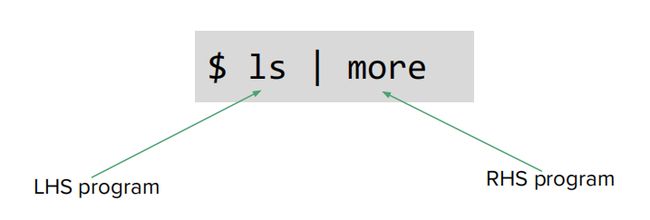Linux管道的实现(c语言)
Linux管道(|)的实现(c语言)
重定向(redirection)
在操作系统中,shell提供了非常方便的重定向命令:
当shell运行一个程序时,它会打开三个文件描述符:0,1,2,默认情况下,它们被连接到终端。例如0是标准输入(键盘),1是标准输出(控制台),2是标准错误输出(控制台)。
管道(pipe)
与其直接将标准输出与设备(如屏幕)相连接,Linux将文件描述符指向内核提供的一片缓冲区。输入端与RHS program相连接,生产数据;输出端与LHS program相连接,消费LHS program的输出。
管道是一个连接两个进程输入输出的缓冲区,这个缓冲区在内存中。文件描述符指向这个管道,管道负责对输入输出(读写操作)进行缓冲。
如图所示,管道将ls进程的标准输出(文件描述符1)与more进程的标准输入(文件描述符0)相连接,充当缓冲区的作用。意思是,ls产生的标准输出将被重定向到管道pipe的缓冲区,more会不断消费这个缓冲区的内容。
文件描述符
文件描述符通常对每个进程都是唯一的,但是它们可以被通过fork产生的子进程所共享,或者被fcntl, dup, dup2函数拷贝。
dup函数
int dup(int oldfd);
函数创建一个文件描述符的拷贝,并且将该文件的引用计数加1,返回最小的可用的文件描述符数字。
dup2函数
int dup2(int oldfd, int newfd);
该函数与dup()函数做同样的工作,但是并不是使用最小的可用文件描述符,而是使用newfd所代表的文件描述符数字。换言之,文件描述符 newfd 进行了调整,指向了oldfd所指向的文件。
如果newfd已经被使用,则先关闭该文件,然后再被重用。相比于先关闭文件描述符,再使用dup()复制,这个重用操作是原子性的。
例如,文件描述符fd已经打开了某个文件,则该代码可将标准输入重定向到这个文件。
#include 多进程
Linux提供了很多方式来创建一个新的进程,例如fork,execve。
fork函数
pid_t fork(void);
fork()函数通过复制调用进程(父进程)来创建一个新的进程(子进程)。子进程和父进程在独立的内存空间内运行。在fork()函数执行的瞬间,子父进程的内存空间内容是相同的。
返回值:子进程中返回0;父进程中返回PID;父进程返回-1代表失败,不会创建子进程,并设置errno。
例如,通过返回值判断子父进程,并执行不同的操作:
#include execve函数
int execve(const char *pathname, char *const argv[], char *const envp[]);
execve()执行pathname路径名所代表的程序,这将会导致调用线程中运行的程序被该程序所替换,并且重新初始化内存空间(堆栈、数据段)。
argv[]为参数列表,以NULL结尾。
envp[]是环境变量列表,格式为:name=value。
当运行成功后,他不会返回任何东西,因为原进程的程序已经被替换。具体地,该函数只会在发生错误时返回-1,并设置errno。
例子:
#include 尽管execve()函数非常强大,但是有其他封装在该函数之上的其他函数,例如execlp(),它们更加简单易用。
execlp函数
int execlp(const char *file, const char *arg, ...);
该函数与execve()大同小异,但是它无需传递环境变量,默认使用PATH环境变量进行file的搜索。其参数以参数列表的形式逐个传递,并以(char*)NULL结尾。
执行ls函数的代码如下。注意,在c语言中,参数列表第一个永远是程序名称:
if (execlp(“ls”, “ls”, (char*)NULL) == -1) {
return errno;
}
pipe函数
int pipe(int fd[2]);
-
pipe()函数用于进程间通信,pipe只能用于单向通信,一个进程写,另一个进程读。 -
如果一个进程想要在另一个进程写入之前从管道中读取,则该进程将被暂停直到有内容被写入管道(类似于调用
scanf()从控制台读取输入时的等待过程)。 -
其中
fd[0]为读端的文件描述符,fd[1]为写端的文件描述符。 -
成功返回0,失败返回-1。
Linux管道命令(|)的实现
程序的参数为命令的列表,例如:
./pipe ls cat wc
- 主进程将会遍历参数列表,逐个创建子进程对命令进行处理。
- 子进程将会用管道将输入输出串联在一起。
- 第一个子进程从标准输入读取数据。
- 最后一个子进程向标准输出输出结果。
- 可以让子进程输出错误到stderr。
首先使用calloc创建子进程pid的列表,方便后续wait操作。
pid_t *pids = (pid_t *)calloc(argc, sizeof(pid_t));
遍历所有命令,为每个命令执行fork()。
- 如果返回负值,报告错误。
- 如果返回0,写子进程代码。
- 如果返回大于0,写父进程代码。
在fork()之前,我们需要创建管道用来重定向子进程的输入输出。
int fds[2];
if (pipe(fds) == -1)
{
perror("pipe create error");
return errno;
}
该代码创建一个管道,其中fds[0]为读端,fds[1]为写端。
所以我们要做的是,把进程的输出绑定到管道的写端,同时将下一个进程的输入绑定到管道的读端,这样前一个进程的输出就被传送到了后一个进程的输入。
思路清晰后,我们需要知道第一个进程的输入应该绑定到哪里。没错,应该是标准输入。同理最后一个进程的输出绑定标准输出。
for (int i = 1; i < argc; i++)
{
// 创建管道
// ...
// fork子进程
int ret = fork();
if (ret < 0)
{
perror("fork error");
return errno;
}
else if (ret == 0) // child
{
pids[i] = getpid();
// 将输入绑定为前一个进程的输出,也就是上一个管道的读端
// ...
// 将输出绑定到新创建的管道的写端
// ...
return 0;
}
else // parent
{
// ...
}
}
我们首先绑定子进程的输出到管道的写端:
for (int i = 1; i < argc; i++)
{
// 创建管道
// ...
// fork子进程
int ret = fork();
if (ret < 0)
{
perror("fork error");
return errno;
}
else if (ret == 0) // child
{
pids[i] = getpid();
// 将输入绑定为前一个进程的输出,也就是上一个管道的读端
// ...
// 将输出绑定到新创建的管道的写端
dup2(fds[1], STDOUT_FILENO);
close(fds[1]); // 绑定后删掉原来重复的文件描述符
return 0;
}
else // parent
{
// ...
}
}
由于我们不止到前一个管道的读端文件描述符是什么,所以这里我们需要一个变量来存储这个文件描述符,命名为previous_out_fd,我们只需要让父进程维护这个变量,每次fork()之后将fd[0]保存到这个变量中即可。
重定向子进程的标准输入到上一个管道的读端:
int fds[2];
for (int i = 1; i < argc; i++)
{
// 创建管道
if (pipe(fds) == -1)
{
perror("pipe create error");
return errno;
}
// fork子进程
int ret = fork();
if (ret < 0)
{
perror("fork error");
return errno;
}
else if (ret == 0) // child
{
pids[i] = getpid();
// 将输入绑定为前一个进程的输出,也就是上一个管道的读端
dup2(previous_out_fd, STDIN_FILENO);
close(previous_out_fd);// 绑定后删掉原来重复的文件描述符
close(fds[0]); // 子进程不需要操作新创建的管道的读端
// 将输出绑定到新创建的管道的写端
dup2(fds[1], STDOUT_FILENO);
close(fds[1]); // 绑定后删掉原来重复的文件描述符
return 0;
}
else // parent
{
/* save the read end, which is the input of the next process */
previous_out_fd = fds[0];
close(fds[1]); // close write end
/* we should'nt close the read end's fd before the child duplicated it */
}
}
注意我们不能在fork()之前保存fds[0]的值,因为如果这样子进程中previous_out_fd的值就成了新创建的管道的读端了,我们要的是前一个管道的读端文件描述符。
重定向最后一个线程的输出到标准输出
由于父进程的标准输出本来就是tty,即控制台,因此最后一个子进程的标准输出不需要重定向,直接继承父进程即可。我们在循环中判断if (i != argc - 1),当到达最后一个子进程时不修改其标准输出。
int fds[2];
for (int i = 1; i < argc; i++)
{
// 创建管道
if (pipe(fds) == -1)
{
perror("pipe create error");
return errno;
}
// fork子进程
int ret = fork();
if (ret < 0)
{
perror("fork error");
return errno;
}
else if (ret == 0) // child
{
pids[i] = getpid();
// 将输入绑定为前一个进程的输出,也就是上一个管道的读端
dup2(previous_out_fd, STDIN_FILENO);
close(previous_out_fd);// 绑定后删掉原来重复的文件描述符
close(fds[0]); // 子进程不需要操作新创建的管道的读端
// 将输出绑定到新创建的管道的写端
if (i != argc - 1)
dup2(fds[1], STDOUT_FILENO);
close(fds[1]); // 绑定后删掉原来重复的文件描述符
return 0;
}
else // parent
{
/* save the read end, which is the input of the next process */
previous_out_fd = fds[0];
close(fds[1]); // close write end
/* we should'nt close the read end's fd before the child duplicated it */
}
}
用管道连接好各个子进程的输入输出后,我们就可以在子进程中执行程序代码了。我们这里直接使用前面提到的execlp()函数覆盖掉子进程原来的程序代码,直接执行新的程序。
int fds[2];
for (int i = 1; i < argc; i++)
{
// 创建管道
if (pipe(fds) == -1)
{
perror("pipe create error");
return errno;
}
// fork子进程
int ret = fork();
if (ret < 0)
{
perror("fork error");
return errno;
}
else if (ret == 0) // child
{
pids[i] = getpid();
// 将输入绑定为前一个进程的输出,也就是上一个管道的读端
dup2(previous_out_fd, STDIN_FILENO);
close(previous_out_fd);// 绑定后删掉原来重复的文件描述符
close(fds[0]); // 子进程不需要操作新创建的管道的读端
// 将输出绑定到新创建的管道的写端
if (i != argc - 1)
dup2(fds[1], STDOUT_FILENO);
close(fds[1]); // 绑定后删掉原来重复的文件描述符
if (execlp(argv[i], argv[i], (char *)NULL) == -1)
{
fprintf(stderr, "pipe: %s: %s\n", argv[i], strerror(errno));
return errno;
}
return 0;
}
else // parent
{
/* save the read end, which is the input of the next process */
previous_out_fd = fds[0];
close(fds[1]); // close write end
/* we should'nt close the read end's fd before the child duplicated it */
}
}
最后,为了防止僵尸进程,我们需要等待进程执行完毕,并且检测其返回值,如果出现错误,返回改错误代码。
int status;
for (int i = 1; i < argc; i++)
{
waitpid(pids[i], &status, 0);
int ret = WEXITSTATUS(status);
if (ret != 0)
return ret;
}
完整代码如下:
#include gitee: https://gitee.com/duguxt/simple-pipe.git


